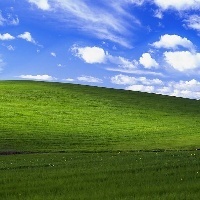Android开发笔记(一百三十)截图和录屏
屏幕捕捉
Android5.0之后开放了屏幕捕捉的API,因此开发者便可以直接通过代码进行截图与录屏,而无需操作系统底层了。屏幕捕捉的功能由MediaProjectionManager媒体投影管理器实现,该管理器的对象从系统服务MEDIA_PROJECTION_SERVICE中获得。注意MediaProjectionManager是Android5.0之后新增的工具,故代码中要补充判断系统版本,如果是4.*及以下版本,则不可处理屏幕捕捉操作。 具体的屏幕捕捉,还要调用媒体投影管理器对象的getMediaProjection方法,获取MediaProjection媒体投影对象。MediaProjection主要有两个方法,说明如下: createVirtualDisplay : 创建虚拟显示层。可分别指定显示层的名称、宽度、高度、密度、标志、渲染表面等等。其中标志通常取值DisplayManager.VIRTUAL_DISPLAY_FLAG_AUTO_MIRROR,渲染表面则按照截图和录屏两种方式分别取值。 stop : 停止投影。 屏幕捕捉的用途主要是截图和录屏,这有点像摄像头的功能,截图对应拍照,而录屏对应录像。对于拍照和录像,我们知道需要创建一个SurfaceView表面视图做为画面预览层,那么就屏幕捕捉而言,也需要创建一个虚拟显示对象做为投影预览层。这个投影预览层即前面createVirtualDisplay方法返回的VirtualDisplay对象,具体的表面对象则为createVirtualDisplay方法中的渲染表面参数,也就是一个Surface对象。如果当前为截图操作,那么调用ImageReader对象的getSurface方法获得渲染表面;如果当前为录屏操作,那么调用MediaCodec对象的createInputSurface方法获得渲染表面。
截图
给屏幕截图用到了ImageReader,它的常用方法说明如下: newInstance : 静态函数,构造一个图像读取器,可指定图像的宽度、高度、色彩模式,以及图像数量。 getSurface : 获取图像的渲染表面。在实现截图功能时,这里的表面对象要作为createVirtualDisplay方法的输入参数。 acquireLatestImage : 获得最近的一幅图像数据。该方法返回Image对象,需转换为Bitmap格式。 下面是把Image对象转换为Bitmap格式的示例代码:
public static Bitmap getBitmap(Image image) {
int width = image.getWidth();
int height = image.getHeight();
Image.Plane[] planes = image.getPlanes();
ByteBuffer buffer = planes[0].getBuffer();
int pixelStride = planes[0].getPixelStride();
int rowStride = planes[0].getRowStride();
int rowPadding = rowStride - pixelStride * width;
Bitmap bitmap = Bitmap.createBitmap(width + rowPadding / pixelStride,
height, Bitmap.Config.ARGB_8888);
bitmap.copyPixelsFromBuffer(buffer);
bitmap = Bitmap.createBitmap(bitmap, 0, 0, width, height);
image.close();
return bitmap;
}截图服务的主要逻辑代码如下所示:
@TargetApi(Build.VERSION_CODES.LOLLIPOP)
public class CaptureService extends Service implements FloatClickListener {
private static final String TAG = "CaptureService";
private MediaProjectionManager mMpMgr;
private MediaProjection mMP;
private ImageReader mImageReader;
private String mImagePath, mImageName;
private int mScreenWidth, mScreenHeight, mScreenDensity;
private VirtualDisplay mVirtualDisplay;
private FloatView mFloatView;
@Override
public IBinder onBind(Intent intent) {
return null;
}
@Override
public void onCreate() {
super.onCreate();
mImagePath = Environment.getExternalStoragePublicDirectory(
Environment.DIRECTORY_DOWNLOADS).getAbsolutePath() + "/ScreenShots/";
mMpMgr = MainApplication.getInstance().getMpMgr();
mScreenWidth = DisplayUtil.getSreenWidth(this);
mScreenHeight = DisplayUtil.getSreenHeight(this);
mScreenDensity = DisplayUtil.getSreenDensityDpi(this);
mImageReader = ImageReader.newInstance(mScreenWidth, mScreenHeight, PixelFormat.RGBA_8888, 2);
if (mFloatView == null) {
mFloatView = new FloatView(MainApplication.getInstance());
mFloatView.setLayout(R.layout.float_capture);
}
mFloatView.setOnFloatListener(this);
}
@Override
public int onStartCommand(Intent intent, int flags, int startId) {
if (mFloatView != null && mFloatView.isShow() == false) {
mFloatView.show();
}
return super.onStartCommand(intent, flags, startId);
}
@Override
public void onFloatClick(View v) {
Toast.makeText(this, "准备截图", Toast.LENGTH_SHORT).show();
mHandler.postDelayed(mStartVirtual, 100); // 准备屏幕
mHandler.postDelayed(mCapture, 500); // 进行截图
mHandler.postDelayed(mStopVirtual, 1000); // 释放屏幕
}
private Handler mHandler = new Handler();
private Runnable mStartVirtual = new Runnable() {
@Override
public void run() {
mFloatView.mContentView.setVisibility(View.INVISIBLE);
if (mMP == null) {
mMP = mMpMgr.getMediaProjection(MainApplication.getInstance().getResultCode(),
MainApplication.getInstance().getResultIntent());
}
mVirtualDisplay = mMP.createVirtualDisplay("capture_screen", mScreenWidth, mScreenHeight,
mScreenDensity, DisplayManager.VIRTUAL_DISPLAY_FLAG_AUTO_MIRROR,
mImageReader.getSurface(), null, null);
}
};
private Runnable mCapture = new Runnable() {
@Override
public void run() {
mImageName = Utils.getNowDateTime() + ".png";
Log.d(TAG, "mImageName=" + mImageName);
Bitmap bitmap = FileUtil.getBitmap(mImageReader.acquireLatestImage());
if (bitmap != null) {
FileUtil.createFile(mImagePath, mImageName);
FileUtil.saveBitmap(mImagePath+mImageName, bitmap, "PNG", 100);
Toast.makeText(CaptureService.this, "截图成功:"+mImagePath+mImageName, Toast.LENGTH_SHORT).show();
} else {
Toast.makeText(CaptureService.this, "截图失败:未截到屏幕图片", Toast.LENGTH_SHORT).show();
}
}
};
private Runnable mStopVirtual = new Runnable() {
@Override
public void run() {
mFloatView.mContentView.setVisibility(View.VISIBLE);
if (mVirtualDisplay != null) {
mVirtualDisplay.release();
mVirtualDisplay = null;
}
}
};
@Override
public void onDestroy() {
if (mFloatView != null && mFloatView.isShow() == true) {
mFloatView.close();
}
if (mMP != null) {
mMP.stop();
}
super.onDestroy();
}
}录屏
把用户在屏幕上的操作行为录制成视频,我们称之为录屏。因为视频有多种格式,不同格式的编码过程也不相同,所以录屏的过程比起截图要复杂得多,主要功能点简述如下: 1、需要控制何时开始录屏,何时结束录屏; 2、设置视频的编码格式,及其对应的编码过程; 3、指定视频的常见播放参数,如尺寸、位率、帧率、色彩等等; 具体到编码实现上,录屏使用了MediaCodec媒体编码器和MediaMuxer媒体转换器两个工具,通过这两个工具的相互配合,方能完成屏幕录制功能。 下面是媒体编码器MediaCodec的主要方法说明: createEncoderByType : 静态函数,根据编码格式构造一个媒体编码器。编码格式通常取值MediaFormat.MIMETYPE_VIDEO_AVC。 configure : 设置媒体编码的参数,包括视频格式、视频宽高、视频位率、视频帧率等等。 createInputSurface : 创建一个用于输入的表面对象。在实现录屏功能时,这里的表面对象要作为createVirtualDisplay方法的输入参数。 start : 开始编码。 dequeueOutputBuffer : 给输出缓冲区排队。返回该输出缓冲区的索引位置。 getOutputFormat : 获取输出格式。 getOutputBuffer : 根据索引位置获取输出缓冲区的数据。 releaseOutputBuffer : 释放指定索引位置的输出缓冲区。 stop : 停止编码。 release : 释放媒体编码资源。 下面是媒体转换器MediaMuxer的主要方法说明: 构造函数 : 根据文件路径与文件格式构造一个媒体转换器。文件格式通常取值MediaMuxer.OutputFormat.MUXER_OUTPUT_MPEG_4。 addTrack : 把指定格式添加到转换轨道上。返回轨道的索引位置。 start : 开始工作。 writeSampleData : 把编码转换后的数据写入索引位置的轨道。该方法在MediaCodec的getOutputBuffer方法之后调用。 stop : 停止工作。 release : 释放媒体转换资源。 由于截图和录屏可用于捕捉其它App的画面,为了让录屏App在其它界面上也能响应控制操作,因此要把录屏App的控制条做成悬浮窗的样式,通过悬浮窗按钮完成截图或者录屏功能。有关悬浮窗的说明参见《Android开发笔记(一百一十八)自定义悬浮窗》。 录屏服务的主要逻辑代码如下所示:
@TargetApi(Build.VERSION_CODES.LOLLIPOP)
public class RecordService extends Service implements FloatClickListener {
private static final String TAG = "RecordService";
private String mVideoPath, mVideoName;
private MediaProjectionManager mMpMgr;
private MediaProjection mMP;
private VirtualDisplay mVirtualDisplay;
private int mScreenWidth, mScreenHeight, mScreenDensity;
private MediaCodec mMediaCodec;
private MediaMuxer mMediaMuxer;
private boolean isRecording = false, isMuxerStarted = false;
private MediaCodec.BufferInfo mBufferInfo = new MediaCodec.BufferInfo();
private int mVideoTrackIndex = -1;
private FloatView mFloatView;
private ImageView iv_record;
@Override
public IBinder onBind(Intent intent) {
return null;
}
@Override
public void onCreate() {
super.onCreate();
mVideoPath = Environment.getExternalStoragePublicDirectory(
Environment.DIRECTORY_DOWNLOADS).getAbsolutePath() + "/ScreenRecords/";
mMpMgr = MainApplication.getInstance().getMpMgr();
mScreenWidth = DisplayUtil.getSreenWidth(this);
mScreenHeight = DisplayUtil.getSreenHeight(this);
mScreenDensity = DisplayUtil.getSreenDensityDpi(this);
if (mFloatView == null) {
mFloatView = new FloatView(MainApplication.getInstance());
mFloatView.setLayout(R.layout.float_record);
}
mFloatView.setOnFloatListener(this);
iv_record = (ImageView) mFloatView.mContentView.findViewById(R.id.iv_record);
}
@Override
public int onStartCommand(Intent intent, int flags, int startId) {
if (mFloatView != null && mFloatView.isShow() == false) {
mFloatView.show();
}
return super.onStartCommand(intent, flags, startId);
}
@Override
public void onFloatClick(View v) {
isRecording = !isRecording;
if (isRecording) {
iv_record.setImageResource(R.drawable.ic_record_pause);
Toast.makeText(RecordService.this, "开始录屏", Toast.LENGTH_SHORT).show();
recordStart();
} else {
iv_record.setImageResource(R.drawable.ic_record_begin);
Toast.makeText(RecordService.this, "结束录屏:"+mVideoPath+mVideoName, Toast.LENGTH_SHORT).show();
}
}
private String prepare() {
MediaFormat format = MediaFormat.createVideoFormat(
MediaFormat.MIMETYPE_VIDEO_AVC, mScreenWidth, mScreenHeight); //视频格式与宽高
format.setInteger(MediaFormat.KEY_BIT_RATE, 300*1024*8); //每秒多少位,这里设置每秒300K
format.setInteger(MediaFormat.KEY_FRAME_RATE, 20); //每秒多少帧,每秒20帧则每帧大小15K
format.setInteger(MediaFormat.KEY_COLOR_FORMAT, MediaCodecInfo.CodecCapabilities.COLOR_FormatSurface); //设置颜色格式
format.setInteger(MediaFormat.KEY_I_FRAME_INTERVAL, 2); //设置关键帧的间隔
try {
mMediaCodec = MediaCodec.createEncoderByType(MediaFormat.MIMETYPE_VIDEO_AVC);
mMediaCodec.configure(format, null, null, MediaCodec.CONFIGURE_FLAG_ENCODE);
mMediaCodec.start(); //开始视频编码
return null;
} catch (Exception e) {
e.printStackTrace();
return e.getMessage();
}
}
private void recordStart() {
String result = prepare();
if (result != null) {
Toast.makeText(this, "准备录屏发生异常:"+result, Toast.LENGTH_SHORT).show();
return;
}
if (mMP == null) {
mMP = mMpMgr.getMediaProjection(MainApplication.getInstance().getResultCode(),
MainApplication.getInstance().getResultIntent());
}
mVirtualDisplay = mMP.createVirtualDisplay("ScreenRecords", mScreenWidth, mScreenHeight, mScreenDensity,
DisplayManager.VIRTUAL_DISPLAY_FLAG_AUTO_MIRROR, mMediaCodec.createInputSurface(), null, null);
new RecordThread().start();
}
private class RecordThread extends Thread {
@Override
public void run() {
try {
Log.d(TAG, "RecordThread Start");
FileUtil.createDir(mVideoPath);
mVideoName = Utils.getNowDateTime() + ".mp4"; //文件格式为MPEG-4
mMediaMuxer = new MediaMuxer(mVideoPath+mVideoName, MediaMuxer.OutputFormat.MUXER_OUTPUT_MPEG_4);
while (isRecording) {
int index = mMediaCodec.dequeueOutputBuffer(mBufferInfo, 10000); //返回缓冲区的索引
Log.d(TAG, "缓冲区的索引为" + index);
if (index == MediaCodec.INFO_OUTPUT_FORMAT_CHANGED) { //输出格式发生变化
if (isMuxerStarted) {
throw new IllegalStateException("输出格式已经发生变化");
}
MediaFormat newFormat = mMediaCodec.getOutputFormat();
mVideoTrackIndex = mMediaMuxer.addTrack(newFormat);
mMediaMuxer.start();
isMuxerStarted = true;
Log.d(TAG, "新的输出格式是:"+newFormat.toString()+",媒体转换器的轨道索引是"+mVideoTrackIndex);
} else if (index == MediaCodec.INFO_TRY_AGAIN_LATER) { //请求超时
Thread.sleep(50);
} else if (index >= 0) { //正常输出
if (!isMuxerStarted) {
throw new IllegalStateException("媒体转换器尚未添加格式轨道");
}
encodeToVideo(index);
mMediaCodec.releaseOutputBuffer(index, false);
}
}
} catch (Exception e) {
e.printStackTrace();
} finally {
release();
}
}
}
private void encodeToVideo(int index) {
ByteBuffer encoded = mMediaCodec.getOutputBuffer(index);
if ((mBufferInfo.flags & MediaCodec.BUFFER_FLAG_CODEC_CONFIG) != 0) { //如果不是媒体数据
mBufferInfo.size = 0;
}
if (mBufferInfo.size == 0) { //缓冲区不存在有效数据
encoded = null;
} else {
Log.d(TAG, "缓冲区大小=" + mBufferInfo.size
+ ", 持续时间=" + mBufferInfo.presentationTimeUs
+ ", 偏移=" + mBufferInfo.offset);
}
if (encoded != null) {
encoded.position(mBufferInfo.offset);
encoded.limit(mBufferInfo.offset + mBufferInfo.size);
mMediaMuxer.writeSampleData(mVideoTrackIndex, encoded, mBufferInfo); //写入视频文件
}
}
private void release() {
isRecording = false;
isMuxerStarted = false;
if (mMediaCodec != null) {
mMediaCodec.stop();
mMediaCodec.release();
mMediaCodec = null;
}
if (mVirtualDisplay != null) {
mVirtualDisplay.release();
mVirtualDisplay = null;
}
if (mMediaMuxer != null) {
mMediaMuxer.stop();
mMediaMuxer.release();
mMediaMuxer = null;
}
}
@Override
public void onDestroy() {
release();
if (mFloatView != null && mFloatView.isShow() == true) {
mFloatView.close();
}
if (mMP != null) {
mMP.stop();
}
super.onDestroy();
}
}
